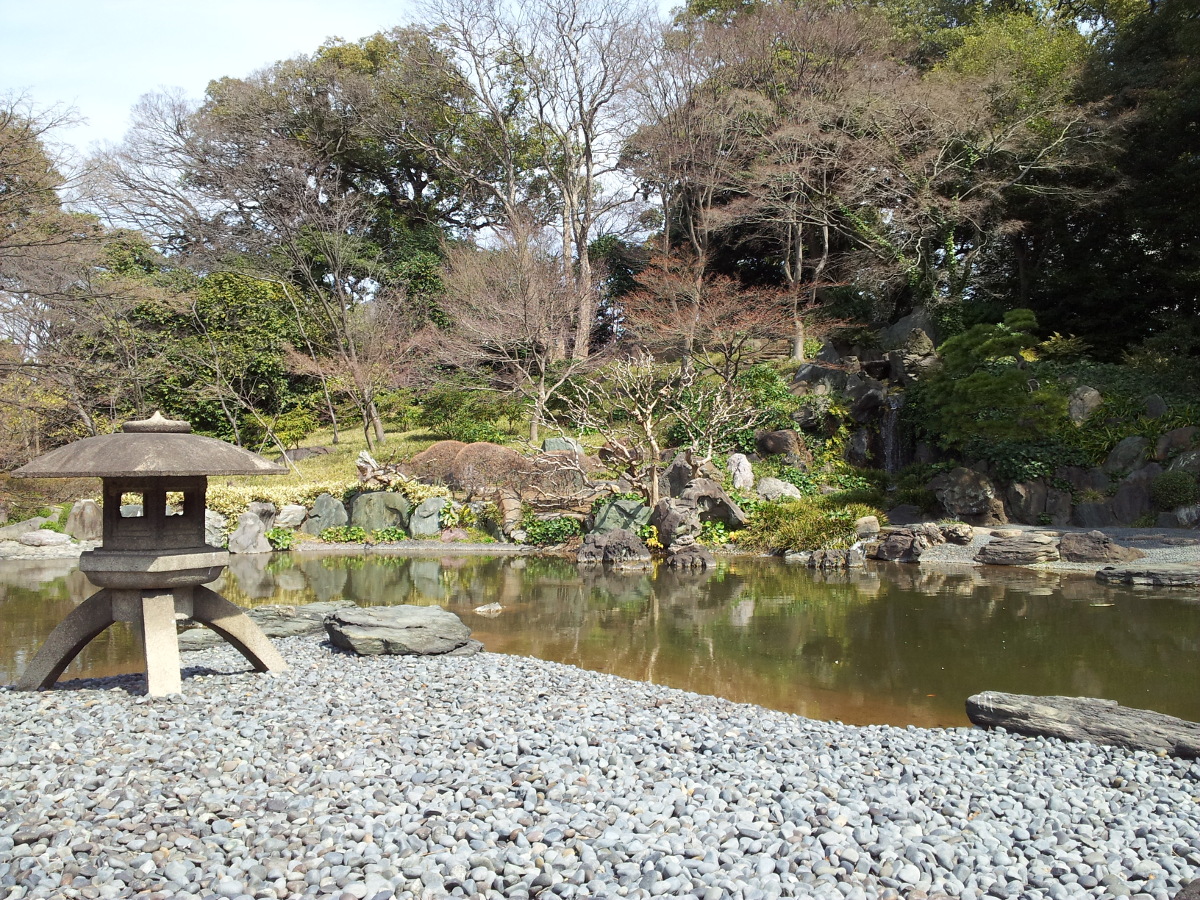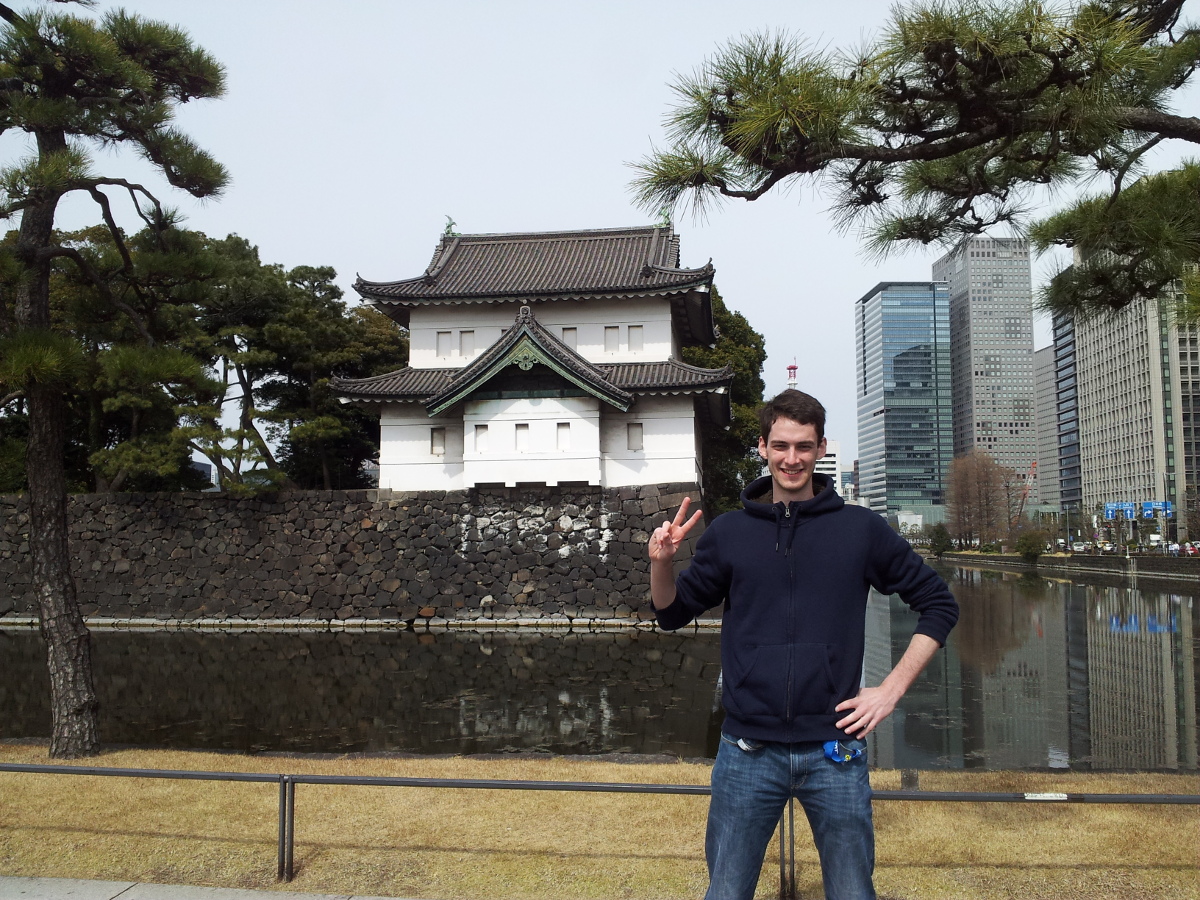Imperial Palace, Shibuya, Yoyogi Park
※ This article discusses our second day in Tokyo, the 18th of March 2017.
In the morning, we usually get up at 07:00. The hostel provides a breakfast, but it is not particularly fancy. Sandwiches (white bread, you can put into a toaster), butter and 4 differently flavored jams are provided. You can also eat hard-boiled eggs (which maybe accidently soft-boiled eggs). In terms of drinks, you can choose between 2 tea flavors and coffee. Sugar and salt is also available. The best combination, Martina found, was toasted sandwich with butter, apple jam and cinnamon sugar. Matcha sugar sounds very Japanese, but was not particularly appropriate for breakfast in my opinion.
Our first destination this day was Chiyoda. This ward covers the area of the Imperial Palace (also called Edo Castle grounds successively Tokyo Castle grounds), where Tennō resides. Remember that Japan is the oldest monarchy of the world. At the entrance, you get an admission ticket. You don’t have to pay any money, but it seems this ticket keeps track of the number of people inside the area. So no-one is lost when the park closes at night. First, we visited East Gardens. The area is very relaxing and the bushes and flowers are well-maintained. On this sunny day, the temperature rose to 9 degrees Celcius. The resting house, located in the shadow, was colder and certainly serves its purpose in summer.

Inside the East Gardens, the west half of the garden contains two circles, you can traverse. A fun fact: In Japanese, circle is called "maru". In the Castle’s Wikipedia article, you will find many areas of the castles named with "maru". If you search the Kanji for "maru", you will find two characters: 丸 and 円 . The second is used to denote the mathematical object. At the same time the character is famously known as symbol to denote the Japanese currency (compare with this image of price tags). So in my mathematics courses I often hear the name of the currency, but actually a circle is meant. By the way, the currency is pronounced "en" in Japan, not "yen".
When we went to the two circles, something very funny happened. I spotted a German-speaking couple. In a glimpse of an eye just before the man passed, I recognized him. I failed to react properly and talk to him, but I looked up his schedule in his weblog and it confirmed my theory: The professor, who examined my master’s degree in September before I came to Japan, visited Japan for a conference. I wrote him an email and he responded that he had to laugh heartily. Yes, he suspected me under the mask, I still wear after the Aikido spring training camp. What a coincidence! Thanks for this awesome moment.
Our next goal was Nijūbashi. This bridge is one of the two main bridges leading the emperor from his residence to the streets. I don’t think they are particularly beautiful. Just a very famous sightseeing spot. I think Tatsumi-yagura is more beautiful (the second image is a historic image):


After lunch, we went to Shibuya. Shibuya is most famous for its scramble intersection. It was featured in Olympic Closing Ceremony 2016 and also Wikipedia’s article on Pedestrian scramble features it. It was indeed amazing. You see a lot of people crossing the intersection. Then you think that now the crowd is gone, but a few seconds later the same number of people gathers again and waits for green traffic lights. After taking photos and filming it, we went into one of the building next to the station. We listened to Japanese music and looked at magazines and DVDs available in the store.
After shopping, we got a little bit tired and went into Tulley’s coffee. I ate a donut and Martina drank a Cocoa. After that break, somebody at the street asked us whether it is okay to interview us. As the interview was in Japanese, Martina was in charge and she answered all questions. I was amazed by her progress in Japanese. The interview was about customs regarding shoes in the house. In Japan, you have to put off your shoes in the Genkan. In Austria, it is the same, but there is no step and the shoes are put on the left or right side inside the entrance area. Because Japanese households are so small, a lack of a shoe box often means chaos inside the Genkan.
Our next destination was Yoyogi Park. It is north of Shibuya. We briefly saw Harajuku (a Youth culture district) from distance, but did not want to put time into this district for now. We entered the park north of Yoyogi National Stadium. It felt like a common park. We saw many foreigners and the Japanese people were in average young. We walked around and sat down. In the meanwhile it got cold and dark. We found a wallet on a bench. We thought about returning it to a Kōban, but we didn’t know one nearby. So we decided to leave it there and I am not sure whether we reacted correctly. It became dark, we wanted to access the Meiji Shrine anyways. Apparently, you cannot access Meiji Shrine from the south directly. We are not sure whether you can access it from the west or north either. But as it turns out the official entrance is in the south-east next to Harajuku station. At this hour, we decided not to go this long path, but visited Yoyogihachiman Shrine, a small shrine west of Yoyogi Park.
Using the train, we went from Yoyogikoen station to Roppongi. The Roppongi Hills Mori Tower is a famous observatory spot. You have to go up 2 floors to enter the building. It was not even sure the towers were still open. I think it closes at 19:30 and we arrived at 19:50. In the end, we decided not to pay the entrance fee of 1800 Yen for the observatory. At the night, you cannot take good pictures, we will visit the Tokyo Tower Observatory anyways and finally, we have been tired.
When going home, we went into a restaurant, to eat some Japanese food. I was very hungry. So I took some ramen and a rice-based dish. Martina only took one dish. I handed over the food ticket to the chef. She discussed it with another staff member and returned one ticket: "This is too much". She argued that both dishes contain rice. I was very hungry, but somehow I got my money back for one dish. So we ate our dishes and I left the restaurant hungry. I am not sure how to think about this incident, but I had some peanuts in the hostel.
Long day, good night!
Conclusion: Imperial Palace has nice gardens, Shibuyia crossing is fascinating and Yoyogi Park is just a common park to relax.